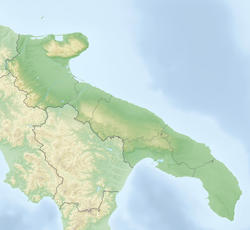| Calcare di Bari | |
|---|---|
| Stratigraphic range: Valanginian-early Turonian ~ | |
| Type | Geological formation |
| Sub-units | Avvantaggio, Montericco, Palorbitoline, Corato, Bisceglie & Sannicandro Members |
| Underlies | Calcare di Altamura |
| Overlies | not observed |
| Area | 100 km2 (39 sq mi) |
| Thickness | Up to 2,000 m (6,600 ft) |
| Lithology | |
| Primary | Limestone |
| Other | Dolomite |
| Location | |
| Coordinates | 41°12′N16°30′E / 41.2°N 16.5°E |
| Approximate paleocoordinates | 24°18′N20°18′E / 24.3°N 20.3°E |
| Region | Apulia |
| Country | Italy |
| Extent | Apulian Platform |
| Type section | |
| Named for | Bari |
| Named by | Valduga |
| Location | Petraro Quarry |
| Year defined | 1965 |
| Coordinates | 41°17′13″N16°17′08″E / 41.2869°N 16.2855°E |
| Region | Apulia |
The Calcare di Bari (Italian for Bari Limestone) is a Cretaceous (Valanginian to early Turonian, spanning approximately 45 million years) geologic formation in Apulia, southeastern Italy. [1] The formation comprises micritic limestones, in places karstified and dolomitized. Rudists and fossil ankylosaur, sauropod and theropod tracks have been reported from the 2,000 metres (6,600 ft) thick formation that was deposited in an inner carbonate platform environment towards the top dominated by rudist reefs.

